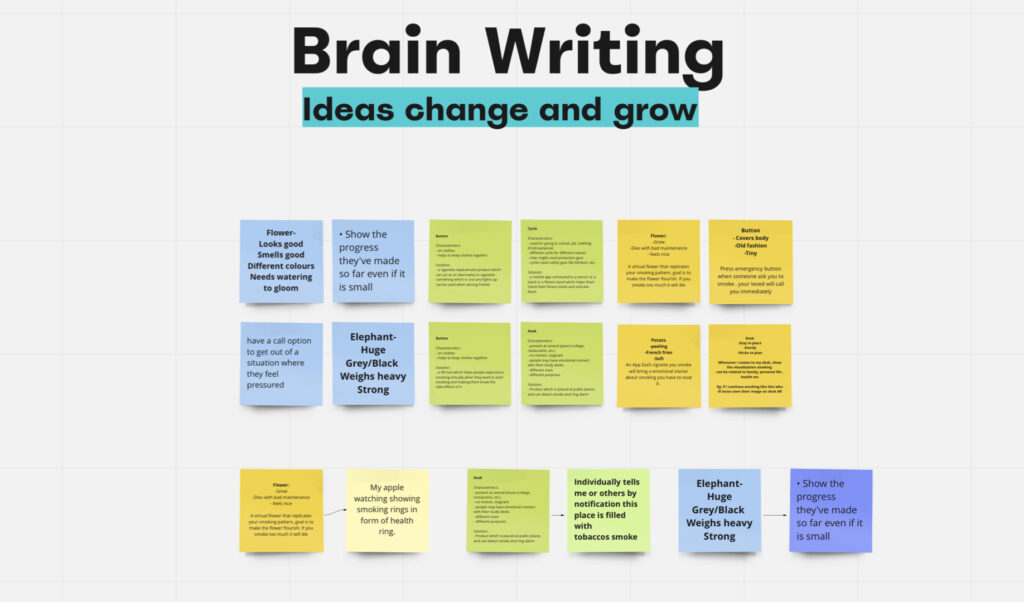NoMore
A Smoking Cessation Product

Company
Indiana University
Role
Researcher, Product designer, Prototyper
Timeline
6 Weeks
Tools
Figma, Blender , After effects
Students are encouraged to address one of the grand challenges of Indiana University for their Mid-term project. Our team chose to overcome addiction as a challenge for this project.
Analyzing and understanding the user’s smoking pattern and bridge it with the behavioural change of the user to overcome the smoking addiction.
No more is a smoking behaviour activity tracker to provide users with personalized experiences to overcome their smoke addiction. This product comes up with a wristband to understand and analyze users' behavioural patterns using hand gesture methods, state and action of the user, primarily during smoking. Furthermore, the product supports an app to provide detailed information on the user's progress in metrics.
Meaningful Interruption

Understands the user’s smoking pattern and interrupt their smoking action in order to reduce the users smoke inhaling percentage E.g., If the user holds a cigarette drag for four seconds, the tracker understands this pattern of the user and intelligently takes the decision to reduce the smoking inhale percentage by indicating the user by haptic feedback at 2.5 seconds of the drag.
Expressive Feedbacks:

Users will be notified about the status and progress of the day using the combination of different haptic and visual feedback from the Band.
E.g. Red indicates the user is entering the intense smoke zone Green says doing well; White indicates the progress of the day.
Personalized Progress

In the App, users will be able to track the progress they have made so far, and also, the App helps them visualize how each data from different features/sensors helps in the overall goal.
E.g., A sleep tracker helps to show the user how much the user’s sleep timing has been improved throughout the journey.
Healthy Motivation

The challenges help the user participate more actively and motivate them to follow through with another active user. The community forum in the App helps to stay motivated and share the progress to motivate others.
For example, users can opt for four weekly challenges, which help people who want to take a break or quit smoking instead of trying for the long process.
Intial Brief
"How might we design a solution for enhancing the in-store shopping experience of Walmart customers"
Why Design thinking as a Design process?
The Design Process used in this project to arrive at a design solution is a variation of the Double Diamond, originally created by the British Design Council.
The process involves discovering insights into a given problem through an exhaustive research, defining the right people and area to focus on, framing concise problem statements, designing potential solutions, and evaluating them to come up with the right solution to be prototyped, tested and built.
Design Thinking

What we got here?
We are designing a solution for smoking addicts to overcome it. Though we have chosen one of the grand challenges from Indiana university still, addiction is a vast domain to jump in. This open-end problem area needs to be narrowed down by prioritizing the significant areas to concentrate on inside addiction.
Clearing the chaos- domain understanding
The main reason for choosing smoking as an attention area is its life-threatening nature and the percentage of people dying. Comparatively, it is much higher than any other addiction consequence. Also, smoking affects smokers and the people around them implicitly. We narrowed our scope down to cigarette smoking during our literature study; we understood cigarette smoking needs more attention compared to other smoking habits like vaping, weed etc. cigarette smoking is one of the significant contributors to deaths by smoking in the USA.
What cigarette smoking does?
14%
Almost 14% of U.S. adults aged 18 or older were cigarette smokers in 2018. (CDC, 2021) = 46.8M.4,80000
More than 4,80000 deaths in the United States yearly due to smoke exposure. (CDC, 2021)70%
Nearly 70% of adults who smoke say they want to quit.
55%
In the United States in 2018, 55% of adult smokers had attempted to quit smoking in the past 12 months. (CDC, 2020)
5%
Only 3% to 5% of smokers successfully quit smoking without professional help.
Interviews
Objective – What I am looking for?
To better understand the smoker, we conducted a semi-structured interview with a smoker who wants to quit and has been smoking for quite some time. Furthermore, we have done an observational study to understand the behaviour and pattern of smokers in their day-to-day life.
Semi-structured interview X 6
Observations X 6


Semi-structured interview and SME interviews
Data gathering
1. What techniques did we use to synthesize the user interview data?
We used standard techniques in industries, namely Affinity diagramming and Empathy Mapping.
2.Who participated in diagramming and mapping activity?
The whole team participated in both activities.
3.How these techniques helped in synthesizing the data?
Empathy mapping provides a glance into our target audience as a whole. The exercise helps us better empathize with the users by addressing what they see, hear, feel, their motivation and pain points. Upon analyzing these, we clearly understand user requirements, which may lead us to develop a better and more organic design solution.
Empathy Mapping

Affinity Mapping
The Affinity Diagramming helps us to quickly organize our findings and insights into small groups and themes based on their relationships. This process supports us in specifying a common understanding of the problem statement.



Giving meaning to the synthesized data
By analyzing the synthesized data from interviews, observation and desk research, we have derived insights that focus on users’ core need to quit smoking. Also, it helps us find the design direction and values users seek and redefine the given brief into narrow downed ones.
Key Insights & HMW's
How might we help the user to connect with the decision emotionally?
- A friend died from an overdose of heroin at the early age of his 20s
- I don’t smoke cigarettes. My grandfather died because of smoking.
01
Pivotal experiences make pivotal decisions in life
How might we help smokers to be aware of good habits?
- Started smoking without peer pressure. was a choice I made
- cigarettes are easily accessible and cheaper compared to alternatives
02
Break a habit to make it a better habit
How might we help smokers to understand the repercussion of passive smoking?
- Smoking helps my appetite, and I tend to eat a good amount of food
- Whenever I try to quit the next day or for a week, I feel weak and fatigue.
03
Not all Hypothesis needs to be believed.
How might we help smokers to overcome social pressure on social smoking?
- I don’t smoke alone. I do it when I’m with my friends.
- How might we help smokers to overcome social pressure on social smoking
04
To Belong, never use smoking.
How might we help smokers to stay motivated and keep trying different ways to quit smoking?
- My family supports me in fighting the addiction to overcome.
- 30 days experiments at the time to quit smoking.
05
Best Experiments make better experiences.
Redefined Brief
"How might we help people build a bridge between user smoking patterns and behavioural change to overcome smoking addiction gradually?"
The problems I identified
From the data synthesizing process, it is evident that the cessation journey has two main problems or miles which every smoker faces and often fails to get; they are
Paused not done
Addiction is an easily relapsing action; over time, users feel they have completed the journey of quitting smoking when they succeed for a certain period. However, often, they start to smoke again. This is because the changes are made on an intentional level, not on the behavioural level.

Lack of Stable support
In quitting, smokers seek extrinsic emotional support and continuous motivation to stay on track. Finding the motivation to do it every day is hard. Considering these core problems users deal with, the direction we are approaching is bringing fundamental behavioural changes instead of adding new behaviour.
Ideation and Downselection
For the next phase of the Design process, we used our research findings and insights to produce potential HMWs (How might we ) for the brainstorming sessions. We used a well-known ice-breaking ideation method called “Random word Ideation” in the first brainstorming,” “Brainwriting ideation” for the second one and finally, the “Creative Matrix method” for the final session. We concentrated on “Quantity over the Quality of ideas” in the random word method. Whereas with the Creative Matrix method, we did the vice-versa.
Why it did not work well for me?
After the first ideation session, we analyzed all our 56 ideas and narrowed down our design direction. Then we conducted the next round of Brainwriting exercises by presenting our top five concepts to fellow students. During the Brainwriting session, we observed that our ideas were far-fetched and out of the box, and it was tough for others to consume our thoughts. Since the problem statements also revolve around the current world issue, we conducted brainstorming sessions to generate more realizable and close-to-reality concepts by keeping the user in the centre.
Creative matrix Ideation
The creative matrix method worked well for me The third brainstorming session is the “Creative matrix Ideation” method which works mainly on the cross-pollination of our insights/HMWs and the technology enablers for the concepts. Using this method, we could develop more viable design ideas for the problem statements.

Card Sorting

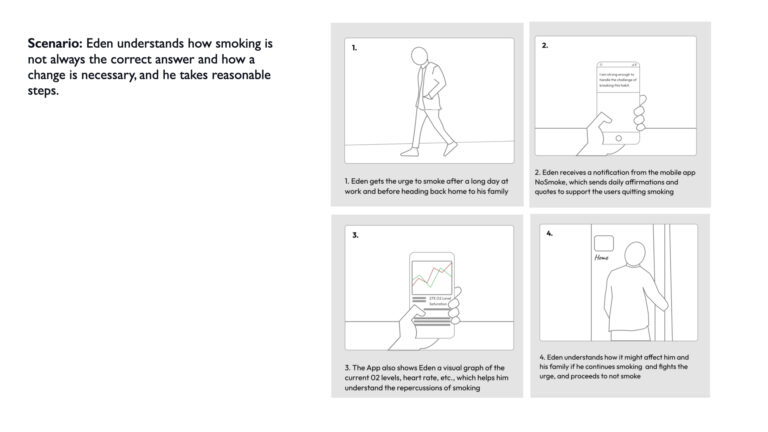
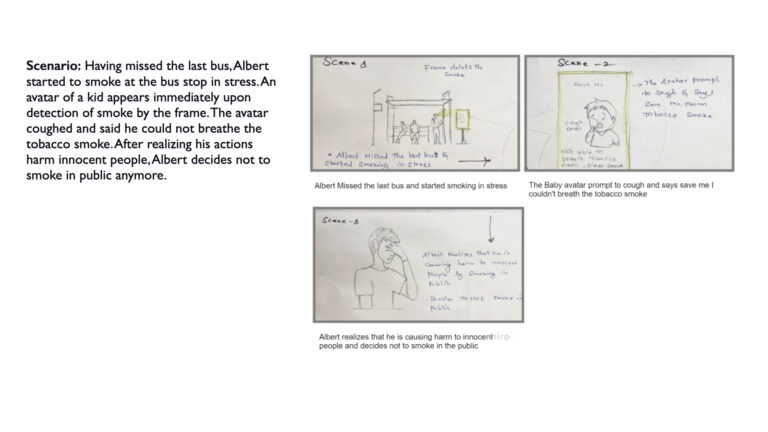

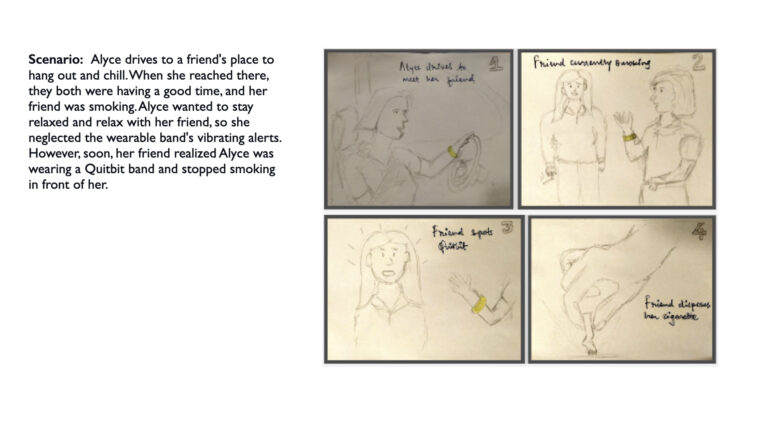
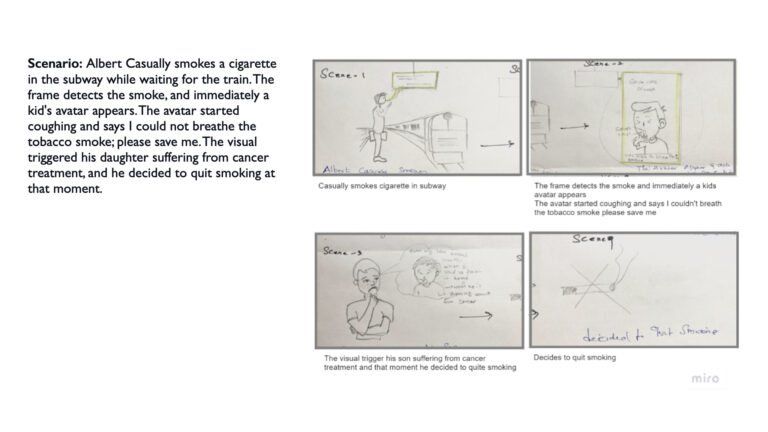
We applied several affinity mapping to synthesize our ideation data to lead to a down-selection process. From the top 60, we have voted the top three ideas that fall under these design principles, Convenient, Behavioural and Motivational.
Downselection
The ideas voted fall under three main buckets, which are informative, experience and engagement—considering these three core aspects as principles for creating a final design idea which will satisfy the user’s need.

Convenient

Behavioural

Motivational
Wireframe
I developed an Information Architecture with a focus on user-centric expertise, aimed at facilitating seamless navigation for users to access the information they require in the most intuitive manner.

What we learned
- The user’s daily progress status is missing in the Band In the Band, users could not understand what the Band is currently used for when the user is not smoking. To check for daily progress or metrics, the user had to open the App, which increases the user’s cognitive load.
- Repetitive feedback causes ambiguity and confusion The initial design of our tracker band has a similar kind of haptic feedback throughout the experience. The action of using a single haptic technique needs to be clarified for the user. The user needed help distinguishing whether the feedback was for an alert or an affirmation.
- Providing limited information, but users want to be educated During our first design phase, we thought bombarding many metrics would overwhelm users, making it hard for them to make sense of the data. So we have provided the information in a minimalist way, but the given solution is way too minimalist. The user cannot relate to or feel the impact of the presented information. They often think about how this data corresponds to my progress.
How we responded
- By displaying the daily progress of the user using visual cues in the Band itself so that the consumption of daily progress will be easier and on the go

- One of the possible solutions would be implementing different variations in the haptic feedback user receives. For example, alert feedback can be long haptic vibration (4.-6 sec), notifying the user they are entering the risk zone. Likewise, every feature showing the variation in haptic feedback might help the user to understand the context with a lesser cognitive load.

- Giving more meaning to the data and making it more consumable, and giving a sense of how the representation is related to the user’s progress of quitting smoking would be a better way to represent the data.

Reflection and retrospect
Minimalism is more than just a clean and simple design. It is more about engagement, connection, and usability of the product. The information given to users should be relatable, and they should be able to gain insights independently. Making the App look good will work as a try-out product, not a sustainable one.
Though we understood the user value and made a concept that satisfies all the user’s core needs. The usage of the right technology is a crucial design decision. If the user is given futuristic or old technology as a solution, people might feel disconnected from the product because it might take users’ cognitive load, which can affect the experience.


